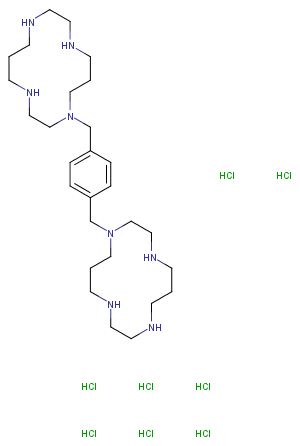Plerixafor octahydrochloride
| Code | Size | Price |
|---|
| TAR-T1776L-5mg | 5mg | £104.00 | |||||||||||||||||||||||||||||||||||||||||||||||||||||||||||||||||||||||||||||||||||||||||||||||||
| Special offer! Add £1 to your order to get a TargetMol CCK-8 Kit. Read more here. | |||||||||||||||||||||||||||||||||||||||||||||||||||||||||||||||||||||||||||||||||||||||||||||||||||
Quantity:
| TAR-T1776L-10mg | 10mg | £117.00 | |||||||||||||||||||||||||||||||||||||||||||||||||||||||||||||||||||||||||||||||||||||||||||||||||
| Special offer! Add £1 to your order to get a TargetMol CCK-8 Kit. Read more here. | |||||||||||||||||||||||||||||||||||||||||||||||||||||||||||||||||||||||||||||||||||||||||||||||||||
Quantity:
| TAR-T1776L-25mg | 25mg | £155.00 | |||||||||||||||||||||||||||||||||||||||||||||||||||||||||||||||||||||||||||||||||||||||||||||||||
| Special offer! Add £1 to your order to get a TargetMol CCK-8 Kit. Read more here. | |||||||||||||||||||||||||||||||||||||||||||||||||||||||||||||||||||||||||||||||||||||||||||||||||||
Quantity:
| TAR-T1776L-50mg | 50mg | £214.00 | |||||||||||||||||||||||||||||||||||||||||||||||||||||||||||||||||||||||||||||||||||||||||||||||||
| Special offer! Add £1 to your order to get a TargetMol CCK-8 Kit. Read more here. | |||||||||||||||||||||||||||||||||||||||||||||||||||||||||||||||||||||||||||||||||||||||||||||||||||
Quantity:
| TAR-T1776L-100mg | 100mg | £332.00 | |||||||||||||||||||||||||||||||||||||||||||||||||||||||||||||||||||||||||||||||||||||||||||||||||
| Special offer! Add £1 to your order to get a TargetMol CCK-8 Kit. Read more here. | |||||||||||||||||||||||||||||||||||||||||||||||||||||||||||||||||||||||||||||||||||||||||||||||||||
Quantity:
| TAR-T1776L-200mg | 200mg | £483.00 | |||||||||||||||||||||||||||||||||||||||||||||||||||||||||||||||||||||||||||||||||||||||||||||||||
| Special offer! Add £1 to your order to get a TargetMol CCK-8 Kit. Read more here. | |||||||||||||||||||||||||||||||||||||||||||||||||||||||||||||||||||||||||||||||||||||||||||||||||||
Quantity:
| TAR-T1776L-500mg | 500mg | £728.00 | |||||||||||||||||||||||||||||||||||||||||||||||||||||||||||||||||||||||||||||||||||||||||||||||||
| Special offer! Add £1 to your order to get a TargetMol CCK-8 Kit. Read more here. | |||||||||||||||||||||||||||||||||||||||||||||||||||||||||||||||||||||||||||||||||||||||||||||||||||
Quantity:
Prices exclude any Taxes / VAT
Overview
Regulatory Status: RUO
Shipping:
cool pack
Storage:
-20℃
Images
Documents
Further Information
Bioactivity:
AMD 3100 octahydrochloride blocks the binding of stromal cell-derived factor (SDF-1alpha) to the cellular receptor CXCR4, resulting in hematopoietic stem cell (HSC) release from bone marrow and HSC movement into the peripheral circulation. Plerixafor is a bicyclam with hematopoietic stem cell-mobilizing activity.
CAS:
155148-31-5
Formula:
C28H62Cl8N8
Molecular Weight:
794.46
Pathway:
Proteases/Proteasome; GPCR/G Protein; Immunology/Inflammation; Autophagy; Microbiology/Virology
Purity:
0.9996
SMILES:
Cl.Cl.Cl.Cl.Cl.Cl.Cl.Cl.C(N1CCCNCCNCCCNCC1)c1ccc(CN2CCCNCCNCCCNCC2)cc1
Target:
Virus Protease; HIV Protease; CXCR
References
1. Zabel BA, et al. J Immunol. 2009, 183(5), 3204-3211.
2. Fricker SP, et al. Biochem Pharmacol. 2006, 72(5), 588-596.
3. Nishimura Y, et al. J Invest Dermatol. 2012, 132(3 Pt 1), 711-720.
4. Kumar S, et al. Bone, 2012, 50(4), 12012-12018.
5. Li Y, Niu M, Zhao A, et al. CXCL12 is involved in ?-synuclein-triggered neuroinflammation of Parkinson?s disease[J]. Journal of Neuroinflammation. 2019, 16(1): 1-14.



